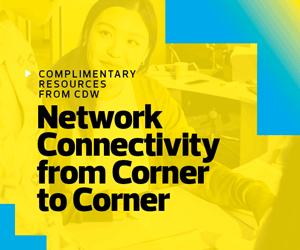The Evolution of Infrastructure in Higher Ed
Whether at home or on campus, reliable internet connections have been the most critical piece of a hybrid workforce-enabling infrastructure. This will remain true going forward. Furthermore, as the shift toward hybrid models becomes permanent, staff will require dedicated computers, monitors, printers and more. But determining who is paying for what will remain a work in progress for many institutions. “We’re still landing on, ‘What’s that setup look like for 100 percent remote work? How much equipment do we deploy?’” says Bryan Garey, vice president of human resources at Virginia Tech.
Workers still coming into campus a few days a week may require an alternative to school office space. This has resulted in an unconventional new trend. “The thing that has really emerged is this idea of hoteling space for people who may be working remotely most of the time. It’s a space where they can come onto campus and temporarily set up shop for a day or two,” says David Weil, CIO at Ithaca College.
RELATED: How the University of Michigan executed a network connectivity upgrade.
The Need for Technology and Beyond
There are numerous technologies needed to enable a hybrid workforce. There are VPNs, for example, Zoom servers and remote-access hardware. There are also collaborative tools like instant chat, shared drives, calendars, PowerPoint, HelloSign and more. Further, there are case management and workflow systems. But according to experts, the question of technology isn’t really about technology. “This cannot be a technology tools conversation,” says Mathew.
Weil elaborates further: “We look at this shift to hybrid, and we need to look at it through three lenses. One is the shift in culture: What does hybrid do for shifting our norms and expectations about how we interact with one another? Two is job functions: How does it change a particular person’s job and what they’re responsible for? The third lens asks, ‘What technology do we need to enable these interactions and connections?” To make decisions about technology with this third lens, the first and second lenses must already be understood.
FIND OUT: 4 tips to ensure secure automated network management in higher ed.
Consider the Logistical and Human Elements
IT departments play an essential role in the transition to more permanent hybrid work models. Logistically, they are needed to help staff set up proper remote workstations, learn how to use them and understand how to practice proper security hygiene. Additionally, once a workforce is up and running, IT will need to contend with any troubleshooting along the way.
IT departments shouldn’t just play a logistical or reactive role. They should be called upon as advocates and architects of hybrid work models. This includes enforcing proper protocols, standards and qualifications for those who work at home. A university or college’s approach to hybrid working shouldn’t be haphazard, and IT is well-positioned to provide proper foresight.
“It’s important for institutions to be intentional and thoughtful with how they think about supporting both faculty and staff,” says Weil. “You have to make sure that they are being supported in how they communicate, how they’re connected, how they get access to files and how they collaborate.”
It’s also important to anticipate what workers need beyond tech. “As we talk about technology, the other hand of this is the human, the emotional, the social aspect,” says Garey. A strategy that moves forward with deliberation, empathy and technical prowess will yield success. “Those who have been intentional about it upfront, they are thriving right now. For those who are being reactive to it, it’s been a bumpy ride,” says Mathew.
LEARN MORE: Machine learning and automation help universities secure their network.











